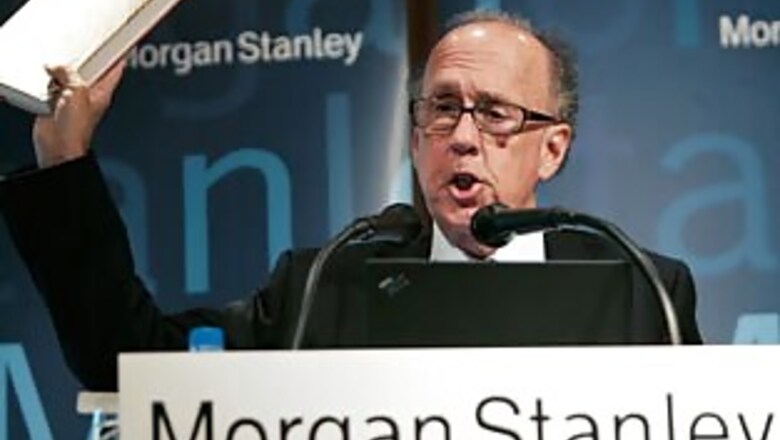
views
Stephen Roach, chief economist, Morgan Stanley, has been warning the world for years about the impending financial crisis. In his new book, The Next Asia, he outlines the opportunities and the challenges for Asian countries for them to effect a change of guard. He spoke to Forbes India's Shishir Prasad about, among other things, why he has started liking India as an investment destination.
Is the world out of the recessionary woods as yet, especially the US?
No, we are not out of the woods as yet. I see many dangers still ahead of us. I am not willing to “greenlight” the recovery. I don’t foresee any economic mega trend or technology trends that can create the consumer demand in the US. Lay-offs are still taking place and I haven’t seen any jumpstarts to the GDP.
You are a huge China fan. But of late you have started liking India. Why?
The case for India has become better in the last six months for one reason: The surprising and encouraging result of the elections. It lays out the possibility of politically driven reforms gathering speed. Then there is the micro-economic story of India which is about high-quality entrepreneurship. When you combine this with the macroeconomic fact of India’s savings rate [about 36 per cent] increasing dramatically, then the story begins to look very good. And it is not that I have turned negative on China. That economy is going through a phase where it will have to face up to some new challenges while India is doing fine for itself. And I don’t think it is either/or. In my view it is India and China and not India versus China.
In the post-recessionary phase, how did China’s macro-managers fare against India’s entrepreneurs? And how did the Chinese consumers fare vis-a-vis Indian consumers?
I think China’s macro-management is its strength. They need to recycle some of that strength into developing their domestic story. It is apparent now that China’s principal export markets are weak and they need to increase their internal private consumption.
The strategy that China has pursued till now [export-led] has inherent limits.
India’s success is in its entrepreneurs but it has to develop a macro-foundation, especially enabling infrastructure. In the last three-four years, the one thing that has changed for the better for India has been its savings rate. It is still less than that of China.
China’s structure of economy is such that only 35 per cent is consumption-led while India’s is about 53 per cent. So China’s economy is much more unbalanced and India’s is better from that point of view. This is China’s wake up call.
At the moment China does not seem to be showing the urgency but I think over the next one year they will come to appreciate this and try and modify their approach from being purely export-led.
PAGE_BREAK
Even if China were to consume more and India were to maintain its consumption would it help? Can they be a credible replacement for the American consumer?
For the time being ‘no’. America’s consumption is close to $9 trillion while China is about $1.2 trillion and India about $650 billion. There is no one who has stepped up to the plate on the demand side to fill the void of the American consumer. This situation will continue for at least three to five years. This is a lesson for the future that you can’t bank on a consumer like the world has done for the past few years on the overextended American consumer.
Has it ever happened in economic history that the world was able to transition away from the leading consumer market?
Not over the time period we are talking, about five to seven years. There are no parallels to this in history but then the world hasn’t quite encountered anything like this before. I see some dynamism in Asian consumer markets but Europe is weak and Japan’s economy has been weak now for almost 10 years. China and India are our only real hopes at this point of time.
People in Asia are now seeing the pain that the American consumer is going through. Why would they want to splurge, especially on foreign goods, and lose the cushion of large reserves?
That’s a serious challenge. Asia’s reserves are a natural outgrowth of the crisis of the 1990s. And that’s where I have a huge problem with people of the Washington Consensus, Mr. Bernanke and Mr. Greenspan, who keep talking about China’s surplus savings. They don’t take into account the fact that China has no social safety net. It is logical for Chinese people to save more.
But I see this as an opportunity for China. If it invests its surplus into developing a social safety net, invests into unemployment insurance and health insurance then these savings can be put to good use.
So is the domestic demand model of India then a better one as compared with the export-led model of China?
No one is perfect. Domestic demand in India is constrained by the reforms that the government needs to enable. And a lot has not happened there. There are few divestments of public sector undertakings. The foreign direct investment rules have not been changed in retail and services.
The RBI has been credited with saving India the extreme economic pain that is there in many parts of the world. Do you agree with the cautious approach that the RBI has shown?
PAGE_BREAK
The RBI, Dr Reddy — that’s one of the great stories of India. They were fiercely independent and withstood the political pressures to have a more accommodating policy. India has benefited tremendously from the wisdom and courage of the RBI. When the world was talking about how difficult it was to spot asset bubbles, the RBI made sure that there was no such event in India.
That’s a lesson for all central banks that they have to avoid asset bubbles at all costs. There are no excuses for allowing excess leverage. I would never want to see a repeat of what has happened just now. And so if the RBI has been cautious it is fine because they have been proven right and India has managed to weather the crisis much better.
How will the world be without leverage and without excess consumption (of the kind shown by American consumer)? What does it mean for corporations around the world?
Absence of leverage would mean that the quality of the financial system will go up while the quantity will come down. The mindless financial engineering of the last five years was a horrible mistake. It added no value.
From a consumption point of view, much of the growth that the world saw in the last five-six years was not real. It was not real income being spent on purchase of those goods. That growth was asset–backed (mostly in the US), where people were looking at the rising price of their houses and feeling they had gotten richer.
Companies will have to change their business model now that this “not-real” demand disappears and consumers don’t have access to credit like they did before. It is going to be challenging for many companies to handle this switch.
You are an American and you have seen the pain that America is going through. How have you reacted to this crisis personally and what’s your advice to people who are living though this?
It is a myth that there exists a shortcut to prosperity. The use of financial engineering and leverage will not make a bad business proposition look good for long. And neither will playing hot stocks from an individual point of view. You have to, as they say in America, get down in the trenches and do the hard work.
Shortcuts are recipe for disaster.




















Comments
0 comment